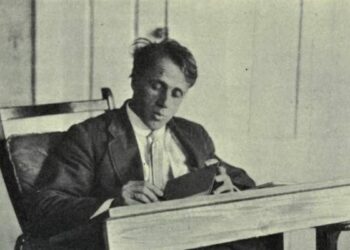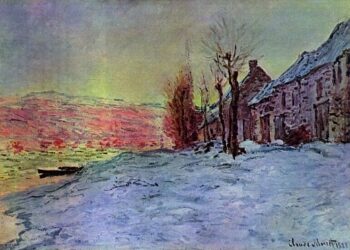A Way to Love God Poem Summary line by line
A Way to Love God is a poem by Robert Penn Warren, a prominent American poet and novelist. The poem delves into complex themes of spirituality, existentialism, and the quest for a meaningful connection with the divine.
A Way to Love God Poem Summary line by line
- “Here is the shadow of truth, for only the shadow is true.”
- The poem begins by suggesting that truth is elusive and can only be grasped indirectly, much like a shadow. This sets the tone for a meditation on the nature of reality.
- “And the line where the incoming swell from the sunset Pacific”
- The poem introduces the setting, with the Pacific Ocean serving as a metaphor for the vastness of existence. The incoming swell symbolizes the constant flow of experiences and challenges in life.
- “First leans and staggers to break on our beach”
- The description of the ocean’s movement reflects the unpredictable and often challenging nature of life’s experiences as they “break” on the shores of our existence.
- “Where the light of the sea forges vaguely the shapes of a dream shore.”
- The play of light on the sea creates dream-like shapes, suggesting the fluid and ethereal nature of the poet’s reflections.
- “And then the ocean increases – its glittering marriage expanses,”
- The ocean is described as expanding, symbolizing the vastness of the universe and the unfolding mysteries of life.
- “Covered with mercury plates, for miles on either side”
- The imagery of mercury plates conveys both the brilliance and the reflective, changeable quality of the ocean’s surface.
- “till it unrolls – becomes a field of light on the level of the air,”
- The poet describes the ocean as transforming into a field of light, blurring the distinctions between sea and sky and highlighting the interconnectedness of existence.
- “to pick up in turns, below the surfs cut paper,
- The surf’s cut paper may represent fragments of experiences or truths that are scattered and waiting to be picked up and understood.
- “the shell, the seaweed, the sand,”
- These natural elements, the shell, seaweed, and sand, serve as symbols of the tangible and transient aspects of life.
- “and then discharging them on the beach in the wild procession.”
- The ocean is described as discharging these elements in a wild procession, suggesting the cyclical nature of life and the continuous flow of experiences.
- “Or on a winter day, or a day like this, to sit, waiting,
- The poem shifts to a different scene, inviting the reader to envision waiting on a winter day or a day with a similar atmosphere, creating a contemplative mood.
- “Till in the distance the little ship of the imagination,”
- The ship of the imagination is introduced, symbolizing the poet’s quest for deeper understanding and insight.
- “At anchor, sails folded, hull motionless in the blue haze,”
- The ship, seemingly at rest, is surrounded by a blue haze, suggesting a state of suspended animation or meditation.
- “And from it the figure leaning against the masthead, looking westward,”
- The figure looking westward embodies a sense of contemplation and anticipation, perhaps searching for meaning or a connection with the divine in the vast expanse of the ocean.
- “while the hands, loosely clasped in the lap, point to the left, the northwest.”
- The hands pointing to the northwest may indicate a direction in which the poet seeks guidance or inspiration.
- “And the ignorant lucky ones sit humped on the dunes, looking eastward.”
- The contrast between the figure on the ship and the “ignorant lucky ones” on the dunes suggests different perspectives and levels of awareness.
- “Then the sun moves, the Pacific drawls in, the little shock waves scamper on the sand.”
- The movement of the sun and the gentle activity of the waves contribute to the dynamic and ever-changing nature of existence.
- “And out of the stillness, a shadow, a movement, a ripple,”
- The poem returns to the theme of the shadow, movement, and ripple, reinforcing the idea that truth is elusive and can be perceived indirectly.
- “Then a light wave, oil on water, a rainbow begins, hangs,”
- The rainbow emerging from the stillness and movement suggests a moment of beauty and revelation, a transient manifestation of something extraordinary.
- “And the hands are lifted from the lap, the left points, the figures turn”
- The lifting of hands and the turning of figures suggest a response to the beauty or revelation, as if being drawn into a deeper understanding.
- “till the figure of the ship with its furled sails and the figure on the shore”
- The ship and the figure on the shore become linked, suggesting a connection between the inner and outer worlds, the seeker and the sought.
- “are specks, twins, dropping the edge of the world into the ocean.”
- The merging of the ship and the figure on the shore into specks or twins symbolizes a unification of perspectives, perhaps a union of the seeker and the divine.
- “Here is the shadow of truth, for only the shadow is true.”
- The poem concludes with a repetition of the opening line, emphasizing the elusive nature of truth and the centrality of shadows in the quest for understanding.
Also Read-
- Anecdote of The Jar Poem Summary line by line
- The River Merchant’s Wife: A Letter Poem Summary line by line
- The Wild Honey Suckle Poem Summary line by line
A Way to Love God
Here is the shadow of truth, for only the shadow is true.
And the line where the incoming swell from the sunset Pacific
First leans and staggers to break will tell all you need to know
About submarine geography, and your father’s death rattle
Provides all biographical data required for the Who’s Who of the dead.
I cannot recall what I started to tell you, but at least
I can say how night-long I have lain under the stars and
Heard mountains moan in their sleep. By daylight,
They remember nothing, and go about their lawful occasions
Of not going anywhere except in slow disintegration. At night
They remember, however, that there is something they cannot remember.
So moan. Theirs is the perfected pain of conscience that
Of forgetting the crime, and I hope you have not suffered it. I have.
I do not recall what had burdened my tongue, but urge you
To think on the slug’s white belly, how sick-slick and soft,
On the hairiness of stars, silver, silver, while the silence
Blows like wind by, and on the sea’s virgin bosom unveiled
To give suck to the wavering serpent of the moon; and,
In the distance, in plaza, piazza, place, platz, and square,
Boot heels, like history being born, on cobbles bang.
Everything seems an echo of something else.
And when, by the hair, the headsman held up the head
Of Mary of Scots, the lips kept on moving,
But without sound. The lips,
They were trying to say something very important.
But I had forgotten to mention an upland
Of wind-tortured stone white in darkness, and tall, but when
No wind, mist gathers, and once on the Sarré at midnight,
I watched the sheep huddling. Their eyes
Stared into nothingness. In that mist-diffused light their eyes
Were stupid and round like the eyes of fat fish in muddy water,
Or of a scholar who has lost faith in his calling.
Their jaws did not move. Shreds
Of dry grass, gray in the gray mist-light, hung
From the side of a jaw, unmoving.
You would think that nothing would ever again happen.
That may be a way to love God.
Conclusion
In “A Way to Love God,” Robert Penn Warren crafts a rich and contemplative exploration of the human quest for truth, spiritual connection, and the ever-changing nature of existence. The poem takes the reader on a journey through the vastness of the Pacific, using its dynamic and elemental imagery to convey the complexity of life’s experiences. Through the metaphor of the ship of imagination, the poet invites reflection on the search for deeper meaning and understanding. The recurring theme of shadows emphasizes the indirect nature of truth, suggesting that the essence of reality is elusive and can only be glimpsed through its shadow. Ultimately, the poem leaves the reader with a sense of awe, wonder, and the recognition that the pursuit of understanding is an ongoing and intricate voyage.
FAQ:
1. Why does the poem mention waiting on a winter day or a day like this?
The mention of waiting on a winter day creates a contemplative mood, inviting readers to envision a scene conducive to reflection and introspection.
2. What is the role of the ship of imagination in the poem?
The ship of imagination symbolizes the poet’s quest for deeper understanding and insight. It represents the human capacity to explore the realms of thought, creativity, and spirituality.
3. What does the figure leaning against the masthead represent?
The figure leaning against the masthead embodies contemplation and anticipation. The westward gaze suggests a seeking of meaning or a connection with the divine.
4. Why does the poem mention the hands pointing to the left, the northwest?
The hands pointing to the left may indicate a direction in which the poet seeks guidance or inspiration. It adds a sense of purpose to the contemplative scene.
5. Why does the poem conclude with the repetition of the line “Here is the shadow of truth, for only the shadow is true”?
The repetition emphasizes the central theme of the poem—that truth is elusive and can only be indirectly perceived through its shadow. It reinforces the idea that the essence of reality is complex and multifaceted.

















